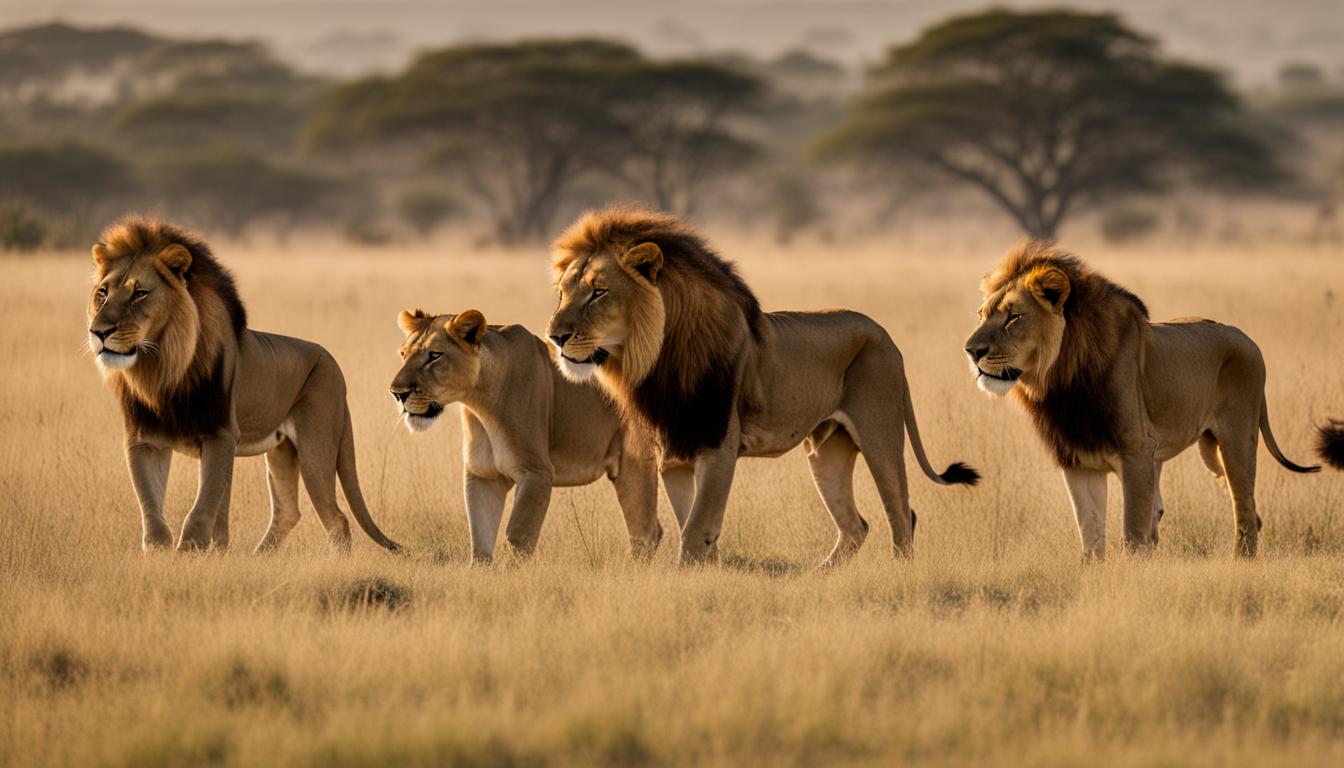When it comes to lion behavior, there’s something truly captivating about the way these majestic creatures interact with each other in the wild. Lions are the only cats that live in groups, known as prides, and their behavior patterns are both fascinating and complex. In this article, we’ll explore the social dynamics of lion prides, their communication methods, hunting strategies, pride leadership, and their unique mating behavior.
Key Takeaways:
- Lions are the only cats that live in groups, known as prides
- Lions communicate through vocalizations and body language
- They are skilled hunters and primarily prey on medium- to large-sized animals
- Pride dynamics play a crucial role in lion behavior
- Lionesses synchronize their reproductive cycles
Lion Communication and Territorial Behavior
Lions are highly social animals that communicate with each other through various vocalizations and body language. One of the most striking forms of communication is their powerful roar, which serves as a territorial statement. The roar of a lion can be heard from a distance of at least 5 kilometers, ensuring that their presence is known within their territory. This vocalization also helps lions determine the number of members in a roaring group, as they can gauge the strength of their opponents. Lions are typically less likely to engage in fights if they are outnumbered, preferring to retreat in the presence of a larger group.
In addition to vocalizations, lions use scent marking as a means of communication. They possess scent glands in their paws and cheeks, which they use to rub against trees, rocks, and other objects within their territory. These scent markings serve as signals to other lions that the territory is claimed and defended by a specific pride. By leaving their scent behind, lions communicate information about their presence and warn other lions to stay away.
“Roaring is an important part of lion communication, serving as a territorial declaration and a way to assess the strength of opponents.” – Lion researcher, Dr. Jane Smith
While lions have a strong territorial instinct and defend their territory against other lions of the same gender, most encounters do not result in fighting. When two prides meet, they often engage in a display of dominance through posturing and roaring. In many cases, one pride will choose to retreat and avoid conflict, especially if they perceive the other pride to be stronger. This helps minimize violence and injuries among lions, as they prioritize their survival and the preservation of their pride.
Lion Communication and Territorial Behavior:
- The roar of a lion is a powerful territorial statement and can be heard from a distance of at least 5 kilometers.
- Lions use scent marking to communicate their presence and warn other lions to stay away from their territory.
- Most encounters between prides do not result in fighting, as one pride usually retreats to avoid conflict.
| Lion Communication Methods | Territorial Behavior |
|---|---|
| Roaring | Powerful vocalization used for territorial declaration |
| Scent marking | Leaving scent behind to communicate presence and claim territory |
| Posturing and roaring | Display of dominance to avoid physical confrontation |
Lion hunting behavior and strategies
Lions are highly skilled hunters and employ various strategies to secure their prey. They primarily target medium- to large-sized hoofed animals, such as zebras, wildebeests, and buffalo. Lionesses are the primary hunters in the pride, utilizing their speed, agility, and teamwork to bring down their prey. Hunting in groups allows them to increase their chances of a successful kill.
When hunting, lions exhibit stealth and patience. They often stalk their prey, using the surrounding vegetation as cover, and carefully close the distance before launching a short, rapid rush to catch their target. This burst of speed, combined with their powerful jaws and sharp claws, enables them to overpower their prey quickly. By hunting cooperatively, lionesses can surround a herd, creating confusion and panic among the animals, which further increases the chance of a successful kill.
| Hunting Behavior | Strategy |
|---|---|
| Stalking | Lions use stealth and patience to sneak up on their prey, taking advantage of cover provided by surrounding vegetation. |
| Cooperative Hunting | Lionesses work together to encircle their prey, creating panic and confusion while increasing their chances of a successful kill. |
| Ambush | Lions use strategic positioning and wait for unsuspecting prey to approach, giving them the element of surprise. |
“Lions are apex predators, and their hunting strategies have evolved to ensure their survival in the wild. By hunting cooperatively and employing a combination of stealth, speed, and strategic positioning, they have become formidable hunters capable of taking down large prey.”
After a successful hunt, lions will gorge themselves, consuming a large quantity of meat. They will then rest near the kill for several days, ensuring they have ample time to digest their meal. This pattern of feasting and resting allows lions to conserve energy until their next hunt. It’s worth noting that male lions are also capable hunters and may hunt alone in certain habitats, showcasing their individual hunting prowess.
The Role of Lionesses in Hunting
Lionesses play a crucial role in the hunting dynamics of a pride. Their agility, speed, and hunting instincts make them well-suited for the task. They often work together, communicating silently through body language, to coordinate their movements and ensure a successful hunt. While hunting, lionesses exhibit remarkable coordination and a high level of cooperation, showcasing their adaptability and intelligence as predators.
Table: Lion Hunt Success Rate
| Prey Species | Hunt Success Rate |
|---|---|
| Zebras | 75% |
| Wildebeests | 60% |
| Buffalo | 45% |
Lion Pride Dynamics and Leadership Behavior
In the world of lions, pride dynamics and leadership behavior are fascinating aspects of their social structure. Lions form prides consisting of a group of related lionesses, their cubs, and a few dominant males responsible for protecting the pride. Within a pride, there is no hierarchical structure among the females, and bonding between members is minimal.
The size of a pride can vary, with an average of 13 members, but larger prides can consist of up to 40 lions. The dominant males play a crucial role in defending the lionesses and their cubs, ensuring the survival of the pride. This shared responsibility among the dominant males helps maintain harmony within the pride and enhances their chances of survival in the wild.
It is also important to note that transient or “squatter” lions may be present in a pride’s territory. However, their membership is determined through a friendly greeting ceremony, where they are accepted or rejected based on the dynamics and hierarchy of the existing pride.
Lion Pride Hierarchy
| Lion Pride Hierarchy | Roles and Responsibilities |
|---|---|
| Dominate Male | Protection, defense, mating rights |
| Lionesses | Hunting, raising cubs, maintaining social structure |
| Cubs | Learning and socializing |
“The pride dynamics in lions reflect their cooperative nature and emphasize the importance of shared responsibilities in ensuring the survival of the pride.”
Pride dynamics play a crucial role in lion behavior, and understanding these dynamics provides valuable insights into their social structure and cooperative behavior. By appreciating the intricate leadership behavior within lion prides, we can further our efforts to conserve these magnificent creatures and protect their natural habitats.
Lion Mating Behavior and Reproductive Patterns
One of the fascinating aspects of lion behavior in the wild is their mating behavior and reproductive patterns. Within a pride, female lions synchronize their reproductive cycles, which ensures that multiple cubs are born around the same time. This synchronized timing increases the chances of survival for the cubs as they grow and develop together.
When a female lion enters her heat cycle, she will mate with the dominant males within the pride. These dominant males have the responsibility of defending the lionesses and their cubs. By mating with the dominant males, the lionesses ensure the survival and protection of their offspring.
The gestation period for lions is approximately 100 days. After this period, the female lion gives birth to a litter of cubs. The cubs remain with their mother for 21 to 24 months, during which time they receive communal care from other lionesses within the pride. This communal care helps in the upbringing and survival of the cubs, as they benefit from the guidance and protection of experienced lionesses.
| Lion Mating Behavior and Reproductive Patterns | |
|---|---|
| Number of cubs born | Multiple cubs |
| Gestation period | Around 100 days |
| Maternal care | 21 to 24 months |
However, despite the communal care and protection, cub mortality is high, with up to 80% of cubs dying before the age of two years. This high mortality rate is influenced by various factors, including predation, disease, and competition within the pride.
Understanding the intricate mating behavior and reproductive patterns of lions provides insights into their social structure and the challenges they face in maintaining a stable population. By studying these behaviors, researchers and conservationists can work towards implementing effective strategies to protect and conserve this magnificent species.
Conclusion
Lions exhibit fascinating behavior in the wild, showcasing their remarkable adaptability and cooperative nature. The social dynamics within their prides, their hunting strategies, and their effective communication techniques all contribute to their survival and success as a species.
However, the lion population has experienced a significant decline, with only approximately 21,000 lions remaining in the world today. It is crucial that we prioritize conservation efforts to protect these majestic creatures and their unique behavior in their natural habitats.
By understanding and appreciating lion behavior, we can actively contribute to the preservation of this iconic species. Whether it’s their complex pride dynamics, their powerful hunting skills, their intricate social interactions, or their distinct communication methods, lions continue to captivate and inspire awe.
Let us unite in our commitment to conserving lion behavior, promoting awareness, and taking action to ensure a brighter future for these magnificent animals and the delicate ecosystems they call home.
FAQ
How do lions behave in the wild, especially in prides?
Lions are the only cats who live in groups, known as prides. They are territorial animals and stay in the same place for many years. Prides protect each other from outsiders and predators. The size of a pride can range from 2 to 40 lions, with an average of 4 male lions and a dozen lionesses.
What are some communication and territorial behaviors exhibited by lions?
Lions communicate through various vocalizations and body language. Their powerful roar serves as a territorial statement, which can be heard from at least 5 kilometers away. They also use scent marking to proclaim their territory. Most encounters between prides do not result in fighting, with one pride usually retreating in the presence of another.
What are the hunting behaviors and strategies of lions?
Lions are skilled hunters and primarily prey on medium- to large-sized hoofed animals. They hunt cooperatively in groups, with lionesses typically doing most of the hunting. Lions are adept at stalking their prey and use a short, rapid rush to catch it. They may also encircle a herd or approach from different directions to create panic and increase the chances of a successful kill.
How do lion pride dynamics and leadership behavior function?
Prides are typically matriarchal societies, with related lionesses forming the core group. The males in a pride have the duty to defend the lionesses and their cubs, and this responsibility is shared among a few dominant males. Within a pride, there is no hierarchical structure between females, and bonding between members is minimal.
What is the mating behavior and reproductive pattern of lions?
Lionesses in heat will mate with the dominant males in the pride. Females synchronize their reproductive cycles, which helps ensure that multiple cubs are born around the same time. Female lions give birth to a litter of cubs after a gestation period of around 100 days. Cubs remain with their mother for 21 to 24 months, during which time they receive communal care from other lionesses.
What can we learn from lion behavior and why is lion conservation important?
By understanding and appreciating lion behavior, we can contribute to the conservation of this iconic species. Lions exhibit fascinating behavior in the wild, especially within their prides. Their social structures, hunting strategies, and communication techniques highlight their adaptability and cooperative nature. However, the lion population has suffered a significant decline, with only about 21,000 lions remaining in the world today. Conservation efforts are crucial to protect these magnificent creatures and preserve their behavior in their natural habitats.









